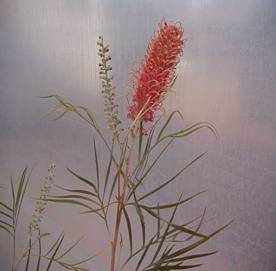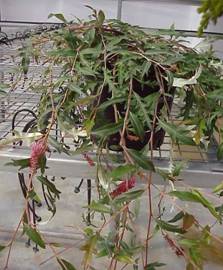
Grevillea ‘Coastal Dawn’

Grevillea ‘Royal Mantle’
Summary of final report on the Australian Flora Foundation funded project:
Santi Krisantini1,2, Margaret Johnston 1, Christine Beveridge 2, & Richard Williams 1
1: School of Agriculture and Horticulture, NRAVS, UQ
2: School of Integrative Biology Department of Botany, ComBinE, BACS, UQ.
Grant Details Final Report
Grevillea (Proteaceae) is one of the woody Australian native species that have high commercial value in the floriculture market. Grevillea spp. vary greatly in their ease of propagation from cuttings, and some Grevillea cultivars are generally considered to be difficult-to-root. Efforts to improve propagation success will be essential in the development of these species for commercial production. The objectives in this study were to study the response of Grevillea cuttings to auxin application, and to determine whether or not rooting differences between difficult and easy-to-root cultivars can be explained by differences in the endogenous auxin levels, or the capability to take up and transport applied auxin.
GC-MS analysis was used to measure the levels of auxin in the rooting zones. The level of auxin in the endogenous pool was measured by adding 13C-labelled IAA (13C6-IAA) and 13C-labelled IBA (13C6-IBA) as internal standards for quantitative mass-spectral analysis. The cultivars G. ‘Royal Mantle” (easy-to-root) and G. ‘Coastal Dawn’ (difficult-to -root) were used for the comparisons. The capacity for auxin transport in cuttings of the two Grevillea cultivars was estimated by applying labeled auxin with high specific activity (3H-IBA, Bioscientific Pty) to the cuttings. Distribution of radioactivity was determined in the base of the cuttings, their leaves and the rest of the stems harvested at various periods after applying auxin.
Apical auxin application to the difficult-to-root cultivar ‘Coastal Dawn’ resulted in a higher or comparable percentage of rooting compared to basal application and might potentially reduce the amount of auxin used to induce rooting. Rooting differences between the difficult and easy-to-root Grevillea cultivars did not appear to be related to their endogenous auxin levels or their ability to take up the applied auxin. There were no significant differences in the endogenous IAA and IBA levels between the easy and difficult-to-root cultivars, and both cultivars demonstrated an increase in endogenous IAA and IBA levels following IBA application. However, a different distribution pattern of the top applied [3H]-IBA was noted between the difficult- and easy-to-root cultivars. The applied IBA in the difficult-to-root cultivar resided in the leaf whereas in the easy-to-root cultivar in the stem base. These studies suggest auxin distribution patterns may be an important factor in adventitious root formation.
